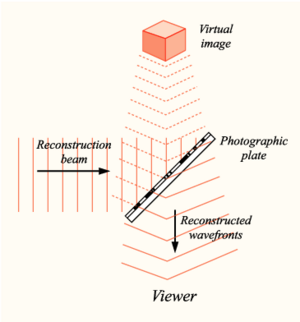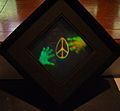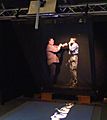Holography facts for kids
Holography is a special way to create three-dimensional (3-D) pictures using a laser. Unlike regular photos, a hologram looks like it has depth and can change slightly as you move, almost like a real object. It uses the way light travels in waves to capture a very detailed image.
Contents
How Holograms Are Made
Holograms are made by shining laser light onto a special plate or screen, a bit like how photos are taken. To make a hologram, part of the laser light, called a "reference beam," goes straight to the screen. Another part of the laser light bounces off the object you want to photograph before hitting the screen.
Lasers are used because their light is very precise. Its wavelength (the distance between light waves) stays the same, which is important for capturing the 3-D information. To prevent other light from messing up the hologram, these pictures are usually taken in a dark room. Even tiny movements can ruin a hologram, so the equipment is often placed on special tables that absorb vibrations from the floor.
Holograms vs. Photographs
Holograms and photographs are both ways to capture images, but they work differently.
- A photograph records only the brightness of light. A hologram records both the brightness and the "phase" of light. The phase tells us about the light wave's position. This extra information is what makes a hologram look 3-D.
- Because a hologram records light from many angles, you can see it from different viewpoints, just like a real object. A photo only shows one flat view.
- You can take a photo with normal light, like from the sun or a lightbulb. Holograms need special laser light.
- To make a hologram, you need a second laser beam (the reference beam) to hit the plate where the hologram is being made.
- If you cut a photo in half, each piece shows only half of the picture. But if you cut a hologram in half, each piece still shows the entire 3-D image! This is because every tiny spot on a hologram holds information about the whole object.
- If you look very closely at a hologram, it doesn't look like a clear picture. Instead, it looks like a random pattern of bumps and swirls.
How Holograms Work
Holography uses two main light waves: a "reference wave" (which goes directly to the plate) and an "object wave" (which bounces off the object). These two waves meet and create a pattern on the film. This pattern saves the "phase information" as light and dark areas. For this to work, both the object wave and the reference wave must have the same wavelength. They usually come from the same laser.
History of Holography
The idea of holography was first developed by a scientist named Dennis Gábor.
- 1947: Dennis Gábor, a physicist, came up with the basic idea of holography. He was trying to make microscopes better.
- 1960: Theodor Maiman invented the laser. Lasers were key to making holography practical.
- 1963: Emmeth Leith and Juris Upatnieks improved how holograms were recorded.
- 1964: Leith and Upatnieks made the first real hologram, showing a toy train and a bird.
- 1965: Juri Nikolajewitsch Denisjuk invented "white-light holography," which made holograms easier to see.
- 1967: The first hologram of a person was created.
- 1968: Stephen A. Benton invented "rainbow-transmission holography," which is often used for security holograms.
- 1971: Dennis Gábor won the Nobel Prize in Physics for inventing holography.
Making and Viewing Holograms
Recording a Hologram
To record a hologram, a laser beam is split into two parts. One part, the "reference beam," goes directly to the special film or plate. The other part, the "object beam," shines on the object you want to record. This object reflects the light onto the same film. Where the two beams meet, they create a detailed interference pattern on the film. This pattern is the hologram.
Reconstructing a Hologram
After the hologram is recorded, the film needs to be developed, similar to how a photograph is processed with chemicals. To see the 3-D image, you shine a laser beam (often the same type of reference wave used to record it) onto the developed film. This light interacts with the pattern on the film and creates a virtual, 3-D image of the original object. This image appears to float in space, even though it's not really there.
Uses of Holography
Measurement
Industries use holograms to measure things very precisely. For example, in the car industry, engineers use holography to check for tiny changes in car parts, like bulges or vibrations. By comparing a hologram of a part before and after it's put under stress (like heat or pressure), they can see how much it has deformed. This helps them find problems and make sure parts are strong and safe.
Data Storage
Holography can also be used to store a lot of information, both pictures and digital data. Imagine storing a huge amount of digital information as tiny patterns of light and dark on a special material. This could lead to very large and fast storage devices in the future.
Images for kids
See also
 In Spanish: Holografía para niños
In Spanish: Holografía para niños








